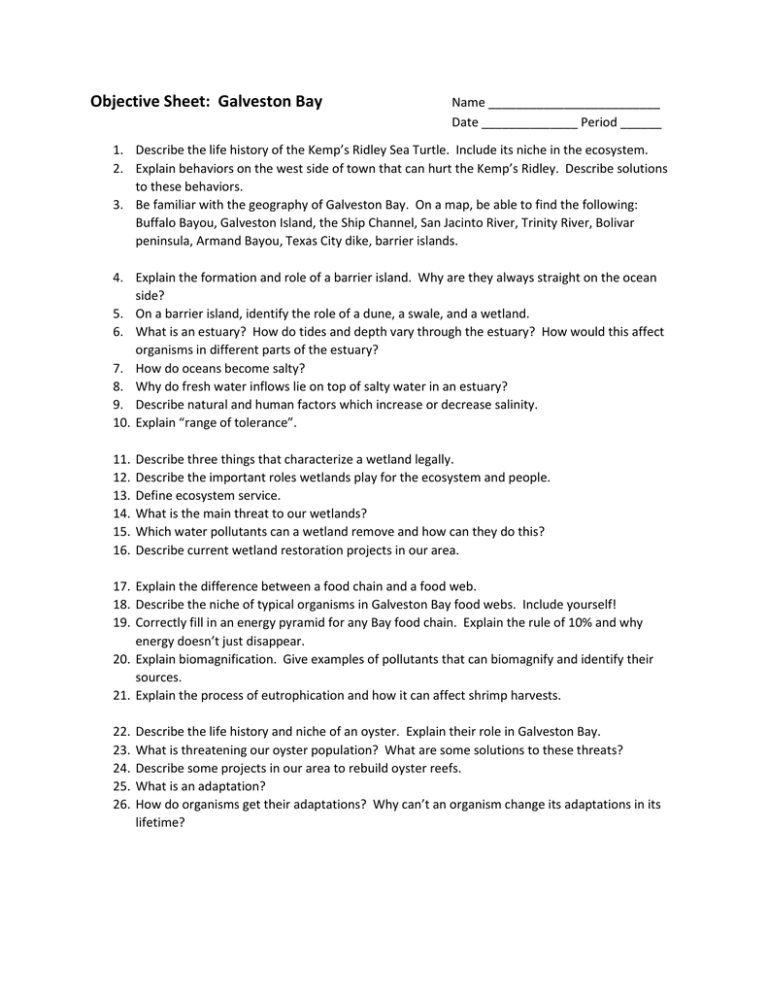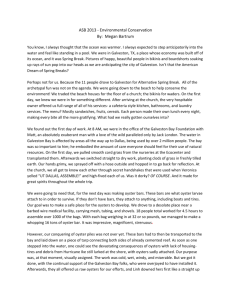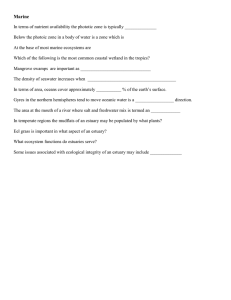Objectives: Galveston Bay
advertisement

Objective Sheet: Galveston Bay Name _________________________ Date ______________ Period ______ 1. Describe the life history of the Kemp’s Ridley Sea Turtle. Include its niche in the ecosystem. 2. Explain behaviors on the west side of town that can hurt the Kemp’s Ridley. Describe solutions to these behaviors. 3. Be familiar with the geography of Galveston Bay. On a map, be able to find the following: Buffalo Bayou, Galveston Island, the Ship Channel, San Jacinto River, Trinity River, Bolivar peninsula, Armand Bayou, Texas City dike, barrier islands. 4. Explain the formation and role of a barrier island. Why are they always straight on the ocean side? 5. On a barrier island, identify the role of a dune, a swale, and a wetland. 6. What is an estuary? How do tides and depth vary through the estuary? How would this affect organisms in different parts of the estuary? 7. How do oceans become salty? 8. Why do fresh water inflows lie on top of salty water in an estuary? 9. Describe natural and human factors which increase or decrease salinity. 10. Explain “range of tolerance”. 11. 12. 13. 14. 15. 16. Describe three things that characterize a wetland legally. Describe the important roles wetlands play for the ecosystem and people. Define ecosystem service. What is the main threat to our wetlands? Which water pollutants can a wetland remove and how can they do this? Describe current wetland restoration projects in our area. 17. Explain the difference between a food chain and a food web. 18. Describe the niche of typical organisms in Galveston Bay food webs. Include yourself! 19. Correctly fill in an energy pyramid for any Bay food chain. Explain the rule of 10% and why energy doesn’t just disappear. 20. Explain biomagnification. Give examples of pollutants that can biomagnify and identify their sources. 21. Explain the process of eutrophication and how it can affect shrimp harvests. 22. 23. 24. 25. 26. Describe the life history and niche of an oyster. Explain their role in Galveston Bay. What is threatening our oyster population? What are some solutions to these threats? Describe some projects in our area to rebuild oyster reefs. What is an adaptation? How do organisms get their adaptations? Why can’t an organism change its adaptations in its lifetime? Mon March 23 Tues March 24 Wed March 25/Thurs March 26 Friday March 27 Start Galveston Bay Unit Geography of the Bay (Interactive Notebook) Quiz – Geography (Obj #3) Wetlands (Interactive notebook) Zaption assignment on HUB HW – Study obj #3 Mon Mar 30 Eng I STAAR Lunch 12:30-1:00 1st pd 1:05 – 2:10 3rd pd 2:15-3:15 Tues Mar 31 (Normal bells) Food Chains (Interactive Notebook) Abiotic factors in an estuary (Interactive Notebook) Barrier islands (Interactive Notebook) Wed April 1 (no joke) Eng II STAAR Lunch 12:30-1:00 5th pd- 1:05 -2:10 7th pd 2:15-3:15 Article Analysis: Oysters: Serfs of the sea Th April 2 2nd – 9:3-11:10 Lunch 4th 12:10-1:40 6th 1:45 – 3:15 Article Analysis: Oysters: Serfs of the sea HW – be ready for quiz on Kemps Ridleys! Monday April 6 Tuesday April 7 Wednesday April 8/Thursday April 9 Quiz – Kemps Ridley Sea Turtles Review day TEST – GALVESTON BAY! Adaptations (Interactive Notebook) Friday April 3 NO SCHOOL – Good Friday


